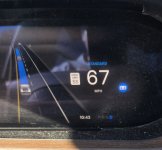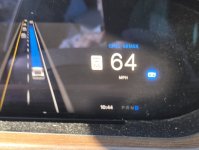I got 12.5.6.3 yesterday, and it's a lot better. Not just the highway part, which in itself is great, but the city/streets part too. I just wrote this in Teslamotorsclub.
2023 MYP here, still with the 2024.8 map. I use FSD a lot, at least since 12.x came out, and I got 12.5.6.3 a couple of days ago. I thought I'd mention some changes I've seen that are not related to the highway mode (which is really good.) These are things that are definitely part of the city/street package - which I did not think had changed since 12.5.4.
1. Stop signs. SOME of the stop signs I normally hit are clearly better. In previous versions, the car always stopped with its front end at the stop sign. I drove to home depot a couple of times today, and the first two of three stop signs both saw the car pulling to a stop with the stop sign almost even with the b-pillar. A half car length past the sign. Then it did a creep and turn as usual. This was remarkable enough that my wife remarked about it. It made the stop slightly faster, but much less goofy. Not all stop signs, because the third sign on my route had me stopping with the front bumper at the sign. No particular visibility issues.
2. No Turn On Red. At least twice in two different locations, the car did not turn right on red where not allowed. Sat at the front of the line through a whole light cycle and never tried to creep forward. Maybe a mapping improvement? It always tried to turn right in those locations before, and I had to intervene.
3. Turn signals - good and bad here. First, it doesn't turn them on too early, usually. Clear improvement there that I attribute to the better route planner. On the other hand, it got blinker happy when changing freeways with a multi-lane exit/transition. Going from I-17 southbound to the 101, there are two exit lanes, one to go east and one to go west. I was going east and already in that lane (thanks early planner!), but the car put on its blinker anyway as we transitioned off I-17. This confused cars coming up in the westbound lane as it looked like I was coming into them. Tesla, if you are not changing a lane (already in the intended lane), do not put on a blinker!
4. Better lane selection. The promised earlier route planner is helping a LOT. Not just on highways. The entire experience is much, much smoother mentally, because it's not in those late lane change decisions any more. That alone makes it seem magical, compared to before, but it's probably just looking ahead another 15-20 seconds? Whatever, it's reduced stress by a lot, simply by changing a bit earlier.
5. Tight turns. I *think* it's going a wee bit faster through them, in general. It was turning like it was racing an old lady in a walker, and losing, but now it seems a little faster.
6. Speed control. That one is pretty hard to talk about without more city streets driving, but it seemed better. It was sticking to just below or just above the speed limit, up until it got into highway mode. (Speed limits 50mph or faster). I did not notice the extreme speed decay I've seen in the past, but a lot of that depends on the road, I think.
That said, I have to talk about highway mode, or perhaps accurately 'speed profiles'. Speed profiles happen at speed limits of 50mph and above, not just freeways.
These profiles are nice. I was pretty used to the old software, which I'd been using since December or so. The new system is very different, and it is more controllable. By using the right thumbwheel (press left to go slower, right to go faster), you can choose between chill, standard and hurry. Around the Phoenix freeway system, there are many 6- and 8-lane freeways, with 3 or 4 lanes on your side, *plus* an HOV lane. Right away I noticed this improvement:
7. The car will (mostly) get into and out of the HOV lane now. (!) I have had to manually get it into the HOV lane by using the turn signal, but at least it went in. And when I needed to get out of it, FSD got out. No more wide-white-line barrier. However, when you get out of the city a bit and the HOV lanes are coming to an end, the wide painted line separating the HOV lane from the others changes to a pair of solid white lines, and FSD won't cross this. You have to disengage to get it into or out of the HOV lane in those areas.
8. Using the speed profiles tends to instantly change lanes when you make a change. Assuming no cars next to you, if you are in Hurry in the left lane, changing to Standard will tend to have you changing lanes in less than 5 seconds. Going from Standard to Hurry tends to do the same, except a bit slower depending on traffic. Putting FSD into Chill tends to make it dive to the right lane. It gives you something new to control the car with, and it's very handy.
9. Max speed is max speed. This is where you finally have control over the car wanting to go 20mph over the speed limit, or you worry about speed traps. If you want the car to do 51mph in a 50, and no faster, set the max to 51. Have someone coming up fast in the fast lane behind you? Flick the thumbwheel once to the left to go from Hurry to Standard, and the car will likely change to the next lane to the right very quickly, without necessarily reducing speed. So you can give you right thumb a lot more of a workout using FSD 12.5.6.x, including control of max speed, and a lot of flexibility on the highway. You can still speed up with the pedal.
The effect of the changes is to make it seem very smooth and relaxing. Most of that from the better planner.




